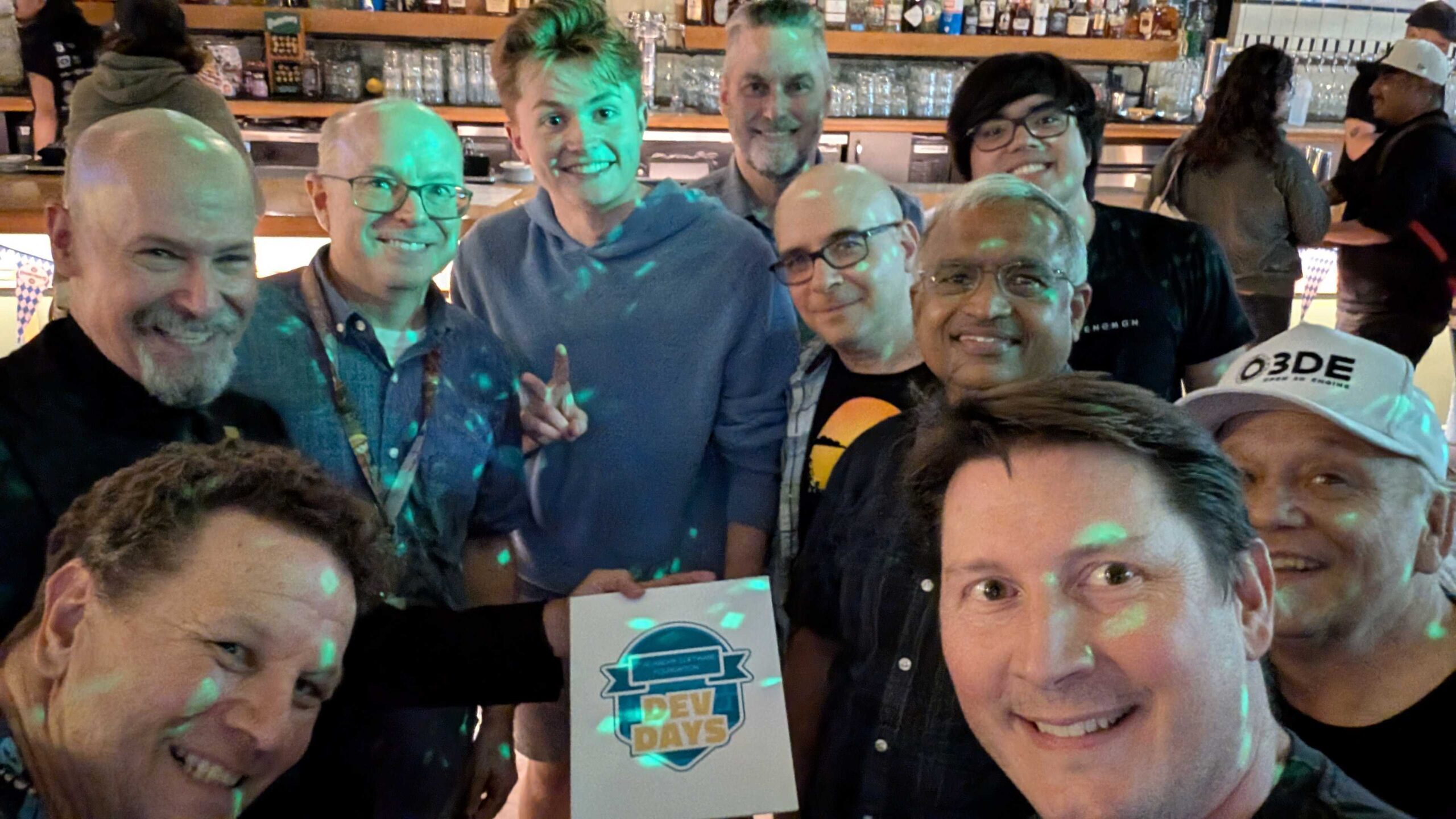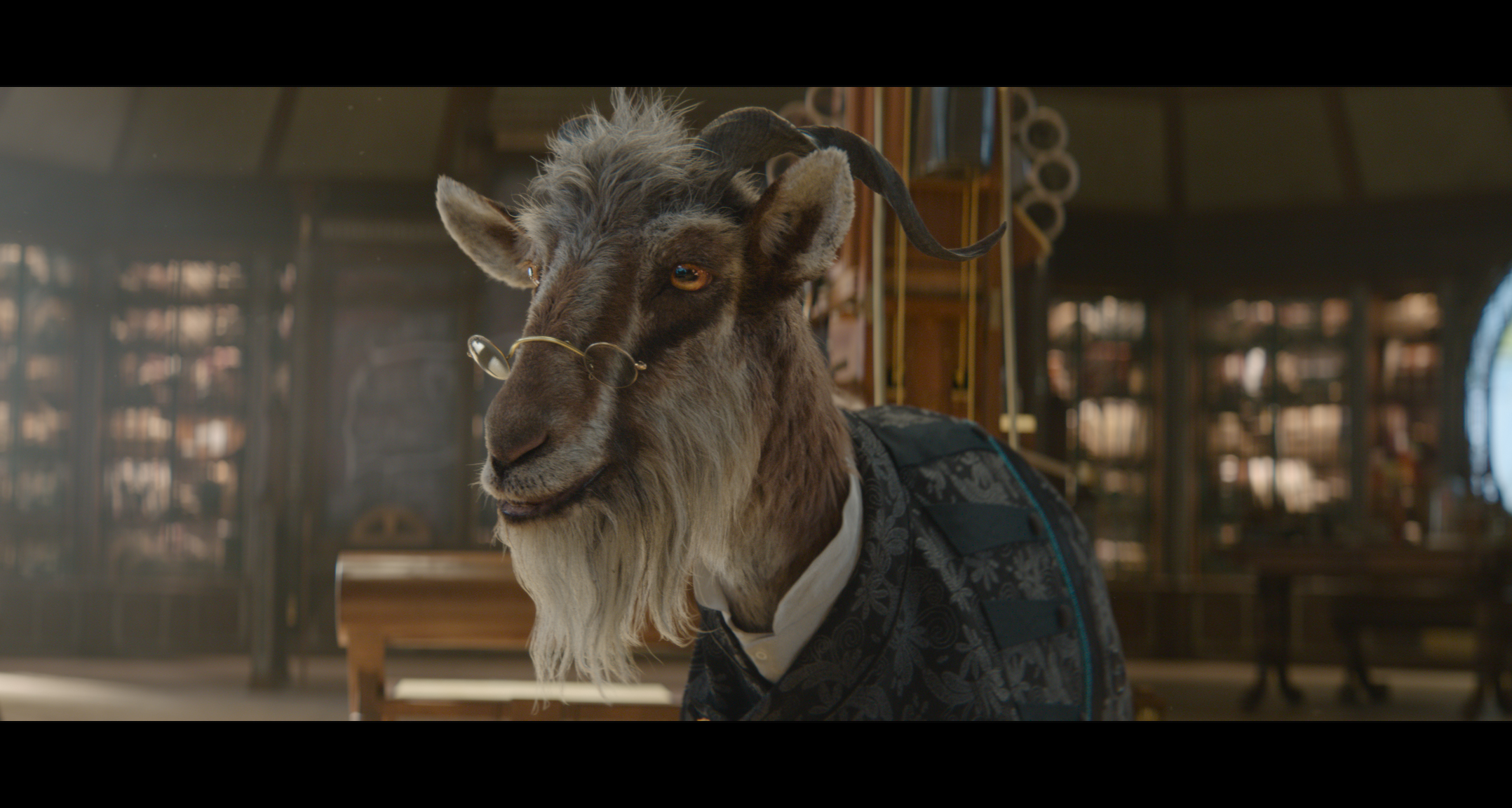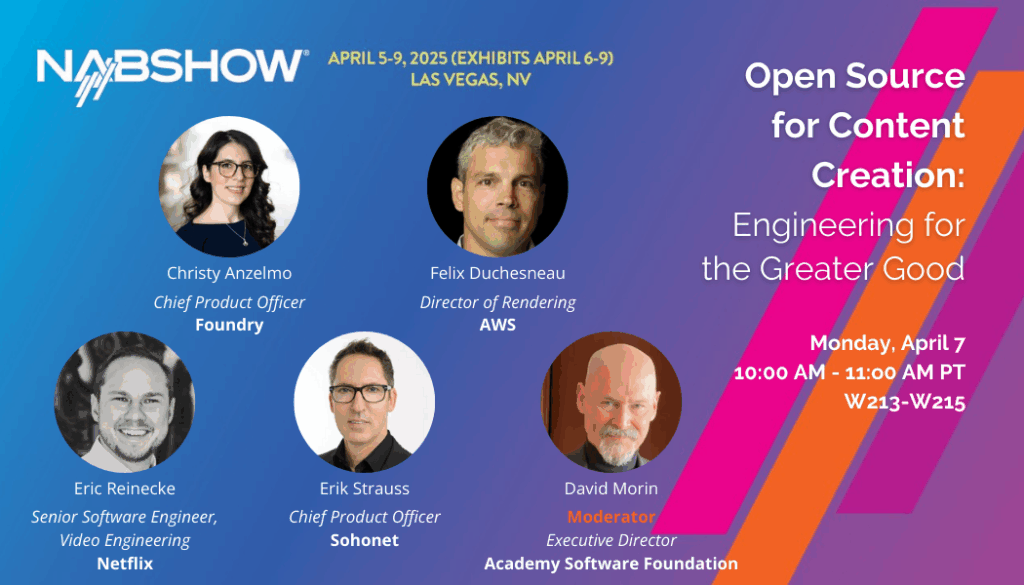
This year for the first time, the Academy Software Foundation was thrilled to have an official presence at the NAB Show with our panel, Open Source for Content Creation: Engineering for the Greater Good. Moderated by the Foundation’s Executive Director, David Morin, the panel brought together Felix Duchesneau (Director of Rendering, AWS), Christy Anzelmo (Chief Product Officer, Foundry), Eric Reinecke (Senior Software Engineer, Netflix), and Erik Strauss (Chief Product Officer, Sohonet) for an engaging discussion covering real-world lessons from their experiences developing open source projects, and the benefits of open source to the broader media industry.
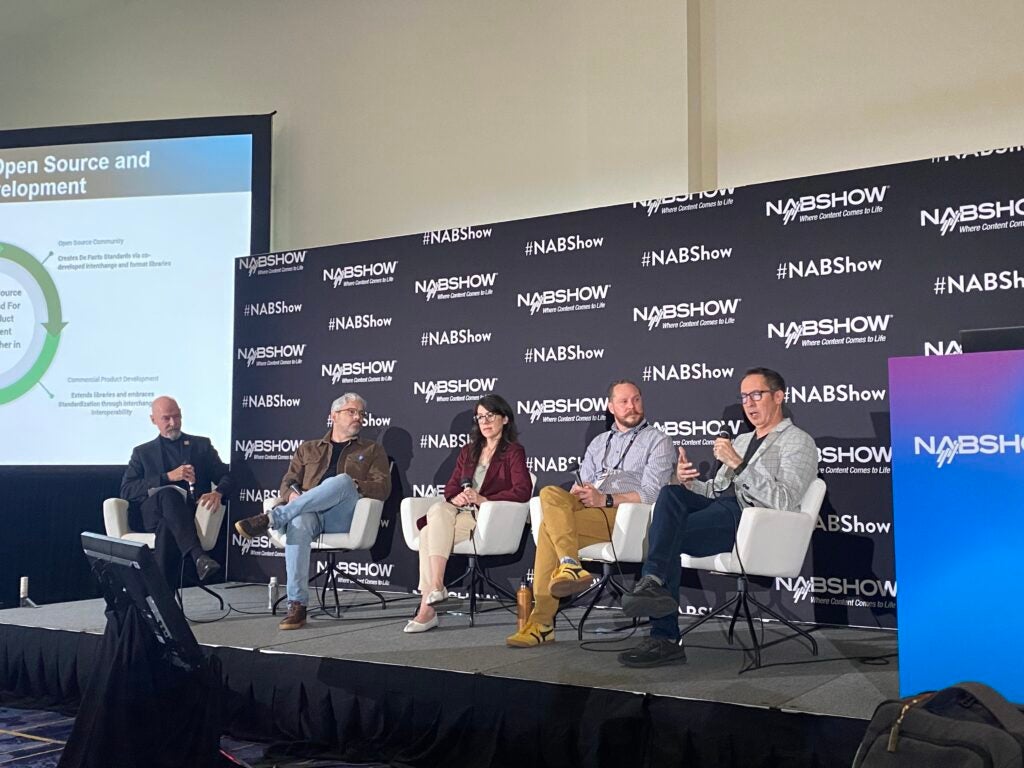
Each of these speakers are leading the way, both within their respective companies and across the larger media & entertainment community, to prioritize open source tools development.
Duchesneau discussed his experience with Amazon Web Services (AWS) Deadline 10 and Deadline Cloud, which both leverage open source under the hood, and Open Job Description (OpenJD), an open specification developed by the Deadline team for describing portable render jobs. AWS released OpenJD publicly last year. Additionally, he mentioned AWS’ in-house experimental production team, FuzzyPixel, which regularly creates its own short films in order to innovate and push the limits of technology. AWS has donated several assets from these R&D projects to the Academy Software Foundation’s Digital Production Example Library (DPEL), a library of digital assets available free of charge to researchers and developers of both open source and commercial projects for professional-grade testing.
Speaking of the benefits of open source within a huge organization such as Amazon, Duchesneau shared, “The benefits of open source are just as true within our own company as they are for the broader industry. Amazon houses everything from MGM Studios to Amazon Games to Amazon Robotics to the AWS Render Array – we benefit from interoperability using the same open standards and specifications across many areas of our company.”
Anzelmo shared an overview of Foundry’s 25+ year history of developing creative software tools and solving real-world production challenges, through its well known applications Nuke, Katana, and Mari. Over the years, Foundry has integrated open source tools such as OpenColorIO and OpenUSD into its software packages. She also discussed OpenAssetIO, an open source project originally developed by Foundry and recently adopted by the Foundation for its continued advancement. OpenAssetIO is an open source interoperability standard for tools and content management systems used in media production, enabling greater communication and interoperability across the pipeline.
“We made the decision to open source OpenAssetIO early on, because it’s inherently a technology that benefits from having more people integrate it,” Anzelmo explained. “Foundry is capable of building out a handful of integrations. But by working with the entire community, we can bring in expertise from all these other areas, whether it’s tools developers or studios doing their own customizations. Having OpenAssetIO be part of the Academy Software Foundation was an excellent platform to bring all of those potential contributors together in one place. We saw this as being essential not only to initial development and adoption, but also for the long-term success and sustainability of OpenAssetIO.”
Reinecke serves as the Technical Steering Committee (TSC) Chair for OpenTimelineIO at the Academy Software Foundation, in addition to his day job as a software engineer on Netflix’s Media Foundations team. He spoke about Netflix’s Media Production Suite, a cloud-based suite of tools developed in partnership with filmmakers. The Media Production Suite leverages open standards to streamline and automate critical processes – such as ACES for color management and OpenTimelineIO for editorial timeline processing – to ensure that Netflix’s wide range of productions can scale globally and operate efficiently.
He also spoke about how open source supports creative flexibility and artistic choice. “We ultimately want to focus on allowing filmmakers to use whatever tools they choose, but the challenge there for engineering is that you can find yourself in a place of having to integrate with every proprietary tool one by one. But if we lean into open source standards, we can focus on creating smooth integrations for that limited set of interchange formats, and from there we can focus on the quality of the integrations rather than the quantity. This also creates a healthy ecosystem that feeds back into itself as adoption for the format grows.”
Strauss, in addition to his role at Sohonet, also serves as the Academy Software Foundation’s TSC Chair for the Open Review Initiative. Formed at the Foundation in 2022 with initial code contributions from Autodesk, DNEG, and Sony Pictures Imageworks, the Open Review Initiative aims to build a unified open source toolset for media playback, review, and approval. Strauss discussed the Open Review Initiative, which houses tools like OpenRV and xSTUDIO, and the crucial partnerships between private companies and open source development.
“A lot of people ask me whether contributing to open source projects is anti-competitive in my business strategy, and I think it’s the complete opposite,” he explained. “The community builds consensus that my products fit a need in the market, and I can differentiate my products to be more flexible and useful by incorporating the open source work to which I contribute. This creates a virtuous cycle between the ways that the broader open source community creates de facto standards, and commercial products then extend their adoption with knowledge of where they’re valuable in the marketplace. Then the open source contributions grow based on increased industry adoption, and it becomes a cycle of continuing investment. There is very clear evidence that you can both successfully contribute to the open source community, and build consumer products that customers want and derive real value from.”
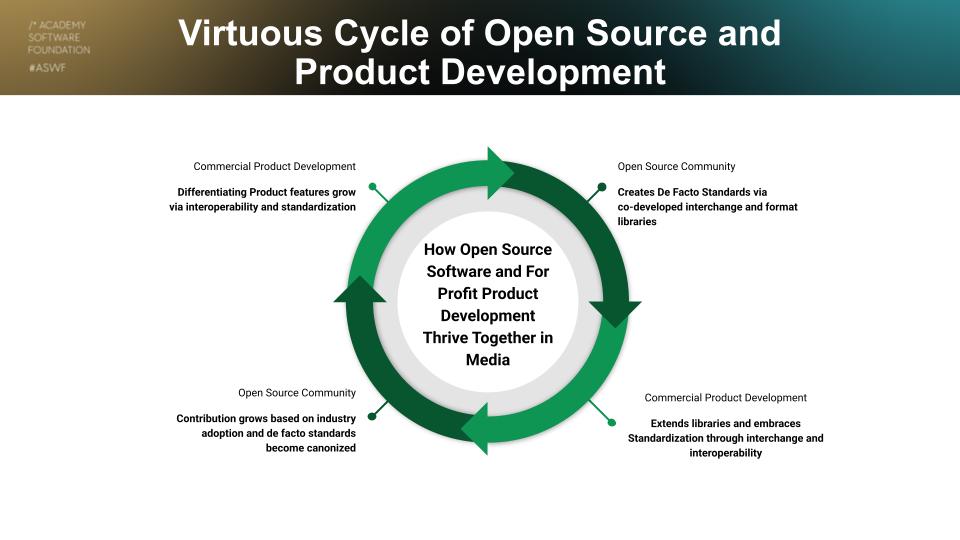
As a timely example, Strauss shared details about the Open Review Initiative’s current effort to build a specification for an interchange format for annotations in the visual effects and animation fields. This is a complicated problem in the industry, with an array of tools that exist across both the authoring and review spaces – making it difficult to maintain the continuity of artistic intent as the content moves across different workflows and ultimately degrades. By pushing for a standard, in this case built around the OpenTimelineIO Timeline Graph, the OpenTimelineIO integration is built directly into a given asynchronous review tool – guaranteeing that artists can get an accurate representation of various expressions of information alongside the media itself. This, in turn, helps increase interoperability with other tools in the overall pipeline.
Reinecke reinforced the idea of open source existing within a virtuous cycle. “If you’re building something that other tools are going to have to integrate with, it’s really valuable to get feedback from those tools developers on it because we can’t possibly know all of the things that are going to exist in our partners’ products and all the new features they are working on,” he explained. “Having that broader context and working in an open and collaborative environment future-proofs us.”
Furthermore, as Anzelmo shared, one way that companies like Foundry differentiate their tools is by building them on top of open source, rather than gatekeeping or building a walled garden around their user base. And the spirit of openness impacts their development process as well.
“It’s fundamental to our tools like Nuke and Katana to keep asking how they can be more efficient and more asset-centric,” she said. “By working within the open source community, we can leverage expertise that’s outside of our wheelhouse. For instance, things like timelines and editorial workflows, or color management – no one company has to have all of the expertise in-house. We can collaborate with really smart people from around the industry in a way that benefits us all.”
Reinecke agreed with the goal of eliminating walled gardens. He shared, “People who still have a walled garden mindset should really examine the fact that all of our tools are being used in a global context, they’re cloud-enabled, and they need to be able to integrate with other tools in other pipelines. It’s just critical that we make sure these tools are open and interoperable, otherwise it’s harder and harder to use them.”
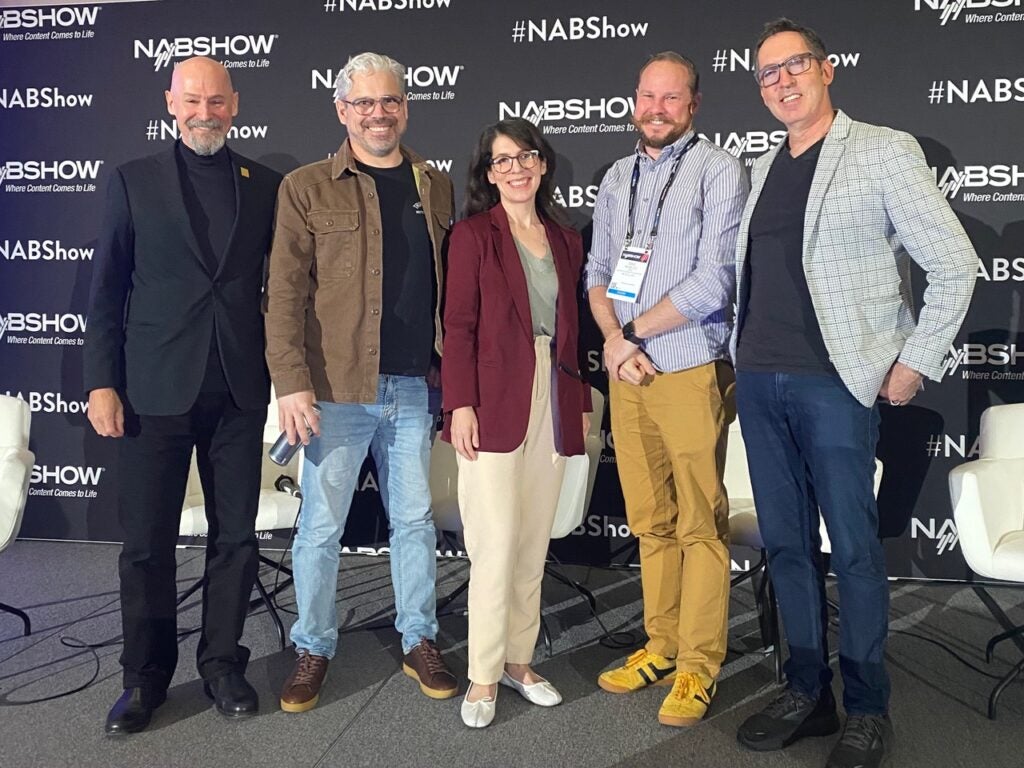
Looking to the future, the group also explored emerging trends among the next generation of filmmakers, who are often independent creators who may have a different viewpoint on how to create and distribute their work. The speakers agreed that the open source community needs to support this next generation, which can be done by continuing to push for standardization and interoperability across emerging and non-traditional tools.
Duchesneau offered, “There are emerging tools redefining how content is being created, and up-and-coming creators who are rethinking traditional approaches – and all of this is impacting traditional media owners. I think there’s a real opportunity for the open source community to engage in conversations with this user base, ensuring long-term interoperability and scalability for all types of content creation moving forward.”
Morin ended the panel by sharing information about various ways to get involved with the Academy Software Foundation. The Foundation will host two Dev Days events this year, on May 15 and September 25. Each of these is a 24-hour virtual hackathon designed to bring in new contributors to the Foundation’s open source projects with straightforward tasks that can be accomplished in one day. These are open to developers of all experience levels, and participants may choose from any of the Academy Software Foundation’s 15 projects for their contributions, including MaterialX, OpenColorIO, and OpenEXR.
In addition, the Foundation will be hosting its annual Open Source Days event on August 10, both virtually and in-person in Vancouver. Open Source Days continues to grow each year, with Virtual Town Halls from each of the Foundation’s open source projects in the lead up to the main day of programming – a full day of presentations from visual effects and animation studios, software vendors, and other industry professionals about emerging trends, best practices, and updates to popular open source projects.
Morin concluded, “It’s gratifying to see how the Academy Software Foundation continues to foster community and cross-company collaboration. Our whole industry works more efficiently when we can tackle common challenges together. Today’s panelists have shown how open source software creates value for businesses by strengthening their tools, streamlining data interchange, and sharing expertise.”
To learn more about ways to get involved with the Academy Software Foundation, visit: https://www.aswf.io/.
